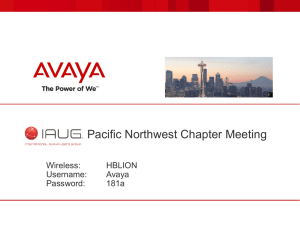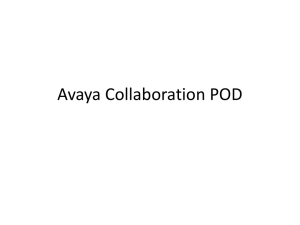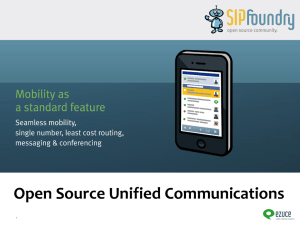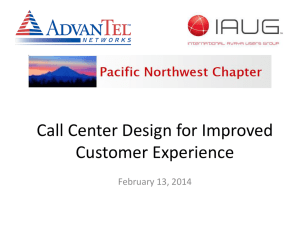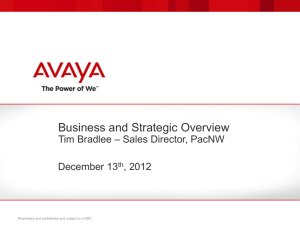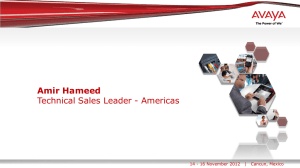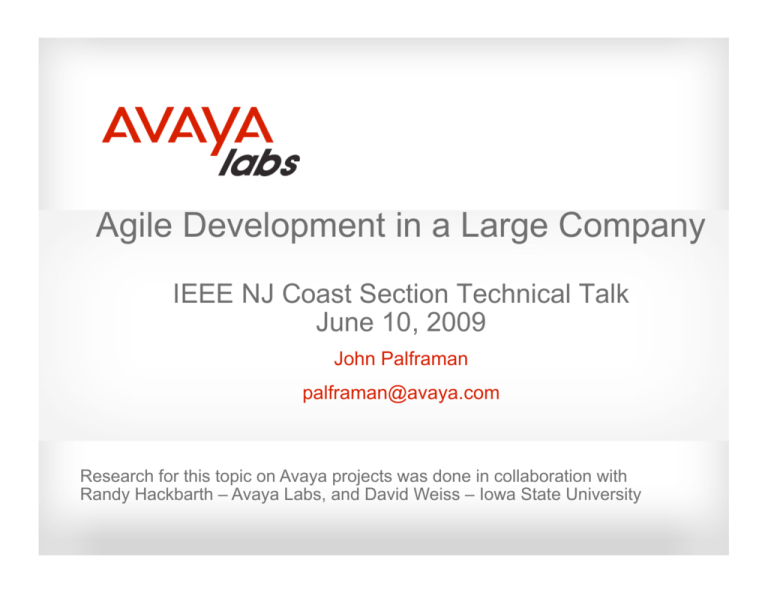
Agile Development in a Large Company
IEEE NJ Coast Section Technical Talk
June 10, 2009
John Palframan
palframan@avaya.com
Research for this topic on Avaya projects was done in collaboration with
Randy Hackbarth – Avaya Labs, and David Weiss – Iowa State University
What Is Iterative and Agile Programming
© 2009 Avaya Inc. All rights reserved.
2
Before Agile – The Waterfall Model
Requirements
Design
Implementation
Verification
Maintenance
h"p://en.wikipedia.org/wiki/Waterfall_model © 2009 Avaya Inc. All rights reserved.
3
Where Waterfall Has Problems
Risk mitigation is postponed
– Design up front, but then may encounter implementation difficulties
– Testing not done until the end, issues may require a redesign
Scope Management
– Requirement always change, especially with a long development cycle
Building the right thing
– Clients usually don’t know what they want until they see a prototype
– Requirements are usually oriented mainly towards functionality
– Studies show a large proportion of early requirements are never used
Because of rework due to the above, cost and time estimates
are difficult
Documentaiton is difficult to keep up to date
“From Waterfall to Evolu<onary Development”, Trond Johansen , Tom Gilb “Understanding The Pros And Cons Of The Waterfall Model Of SoNware Development”, Melonfire “A Rational Design Process: How and Why to Fake It”, Dave Parnis “Managing The Development Of Large SoNware Systems”, Dr. Winston W. Rovce
© 2009 Avaya Inc. All rights reserved.
4
Waterfall Studies
UK study of 1,027 projects:
– 87% failure rate
– 82% cited waterfall-style scope management as the "single largest
contributing factor for failure"
1995 study of $37M worth of DoD projects
– 46% of the systems so egregiously did not meet the real needs
(although they met the specifications) that they were never
successfully used
– 20% required extensive rework to be usable
Study of 6,700 projects:
– Four out of the five key factors contributing to project failure were
associated with and aggravated by the waterfall model
– Inability to deal with changing requirements
– Problems with late integration
Study of over 400 waterfall projects:
– Only 10% of the developed code was actually deployed
– Only 2% was actually used
"Agile and Itera<ve Development: A Manager's Guide”, Craig Larman © 2009 Avaya Inc. All rights reserved.
5
Iterative Development
h"p://en.wikipedia.org/wiki/Itera<ve_development © 2009 Avaya Inc. All rights reserved.
6
Agile Development
• A group of software development methodologies
based on iterative development
• Requirements and solutions evolve through
collaboration between self-organizing crossfunctional teams
h"p://en.wikipedia.org/wiki/Agile_soNware_development © 2009 Avaya Inc. All rights reserved.
7
Traditional vs Agile
h"p://www.versionone.com/Resources/AgileBenefits.asp © 2009 Avaya Inc. All rights reserved.
8
Manifesto for Agile Software Development
We are uncovering better ways of developing software by doing it and
helping others do it. Through this work we have come to value:
• Individuals and interactions over processes and tools
• Working software over comprehensive documentation
• Customer collaboration over contract negotiation
• Responding to change over following a plan
That is, while there is value in the items on the right, we value the items
on the left more.
Kent Beck, Mike Beedle, Arie van Bennekum, Alistair Cockburn, Ward
Cunningham, Martin Fowler, James Grenning, Jim Highsmith, Andrew
Hunt, Ron Jeffries, Jon Kern, Brian Marick
h"p://agilemanifesto.org/ © 2009 Avaya Inc. All rights reserved.
9
Principles behind the Agile Manifesto
1. Our highest priority is to satisfy the customer through early and continuous delivery of
valuable software.
2. Welcome changing requirements, even late in development. Agile processes harness change
for the customer's competitive advantage.
3. Deliver working software frequently, from a couple of weeks to a couple of months, with a
preference to the shorter timescale.
4. Business people and developers must work together daily throughout the project.
5. Build projects around motivated individuals. Give them the environment and support they
need, and trust them to get the job done.
6. The most efficient and effective method of conveying information to and within a development
team is face-to-face conversation.
7. Working software is the primary measure of progress.
8. Agile processes promote sustainable development. The sponsors, developers, and users should
be able to maintain a constant pace indefinitely.
9. Continuous attention to technical excellence and good design enhances agility.
10. Simplicity--the art of maximizing the amount of work not done--is essential.
11. The best architectures, requirements, and designs emerge from self-organizing teams.
12. At regular intervals, the team reflects on how to become more effective, then tunes and adjusts
its behavior accordingly.
h"p://agilemanifesto.org/ © 2009 Avaya Inc. All rights reserved.
10
% of Companies Using Agile Using Selected Agile
Methodologies
h"p://www.versionone.com/Resources/AgileMethodologies.asp “Best Prac<ces: SoNware Development Processes”, David West, April 15, 2009 © 2009 Avaya Inc. All rights reserved.
11
Agile – Commonalities
Frequent Deliveries
Base kept at a high quality level throughout
development
Team is empowered, self organized, accountable
Large Amount of Communications/Interactions
Among Members
Stakeholder Involvement
Transparency
Disciplined project management process
© 2009 Avaya Inc. All rights reserved.
12
XP – Kent Beck
Deliver high-quality software (Simple Designs, Pair
Programming, Test-Driven Development, Refactoring, Continuous
Integration, Collective Code Ownership, Coding Standards)
Deliver quickly and continuously (every 1-3 weeks)
High customer involvement (acceptance tests, on-site)
Rapid Feedback Loops
Continuous Planning and Testing
h"p://www.extremeprogramming.org/ © 2009 Avaya Inc. All rights reserved.
13
Other Methodologies
FDD
Domain Object Modeling
Developing by Feature
Component/Class Ownership
Design/Build by Feature Teams
Inspections
Config Management
Regular Builds
Visibility of progress and result
Crystal
Tailor to characteristics
(team size, criticality, priorities..)
Teamwork
Communications
Simplicity
Ongoing process improvement
DDSM
Business Needs/Value
Risk Analysis & Mitigation
Planning
Active User Involvement
Empowered Teams
Frequent Deliveries
Testing Throughput Development
Stakeholder Collaboration
Lean
Eliminating Waste
Amplifying Learning
Deciding as Late as Possible
Delivering as Fast as Possible
Empowering the Team
Building Integrity In
Seeing the Whole
© 2009 Avaya Inc. All rights reserved.
14
SCRUM
Product Owner
(re)prioritizes
backlog
each sprint
Sprint
Planning
Meeting
Scrummaster: removes obstacles
Collaborative Project Team
Timeboxed
Iterations
Sprint
Retrospective
“Done”
Transparency in planning and module development
Base breakage minimized
h"p://www.controlchaos.com Scrum in 10 Minutes: h"p://www.youtube.com/watch?v=Q5k7a9YEoUI&fmt=22 15
© 2009 Avaya Inc. All rights reserved.
SCRUM - Tools
Product Backlog
– Prioritized list of features, infrastructure items, wish-list items
– Rough estimates of business value and development effort
Sprint Backlog
– User Stories broken into tasks & staff hours
– Tasks prioritized and team members sign-up to develop
Burn Downfor tasks completed (and Burn-Up for projects)
– Public, up-to-date display of progress on sprint backlog
Project Management Tools such as Rally or Scrumworks
h"p://en.wikipedia.org/wiki/Scrum_(development) © 2009 Avaya Inc. All rights reserved.
16
SCRUM - Project Management (1/2)
http://www.rallydev.com/
© 2009 Avaya Inc. All rights reserved.
17
SCRUM - Project Management (2/2)
© 2009 Avaya Inc. All rights reserved.
18
Challenges of Deploying Agile In a Large
Enterprise
Large distributed projects
Code base could be 10s of millions of lines of code
– Code ownership
– Frequent builds
Interworking with many other products (being developed
simultaneously) with consistent policies, look and feel,
“common” resources….
Mission critical reliability
Millions of lines of legacy code, perhaps with no
automated tests
May only have indirect contact with end customers
© 2009 Avaya Inc. All rights reserved.
19
What Is Avaya
© 2009 Avaya Inc. All rights reserved.
20
Avaya – Enterprise Communications
2000
Converged Communications
Unified Messaging
Contact Centers
Communications Enabled
Business Processes
http://www.avaya.com
Octel
Lannet
Soundlogic CTI
Mosaix
CCOM
TKM
Communications
Prominet
Quadriek
SX Business
Systems PLC
Triple C Call Center
Agile Networks
Agile
Ubiquity
Traverse Networks
iSphere
Tenovis
NimCat
RouteScience
Spectel
Tata
Expanets
VISTA IT
Conita
Quintus
VPNet
© 2009 Avaya Inc. All rights reserved.
21
Converged Communications
Converged
Communication
VoIP (Voice over IP i.e. Internet) and Traditional
Switches, Gateways, Phones, Control Interfaces (API) for
Small
Office
SIP, IP, Digital &
Analog
Cross Network
Management
Small
Branch
Mid-Size
Campus
Global
Enterprise
Targeting industry segments with special features: e.g.
Financial:
Highly reliable 99.999% = 5 minutes downtime a year)
Hotel
Access to hotel services
Wakeup calls
Scale
Security
Simplification
© 2009 Avaya Inc. All rights reserved.
22
Unified Communications
Unified
Communication
Unified Access
Mobility
Telephony
Messaging
Conferencing
Video
Presence
Multi Vendor
© 2009 Avaya Inc. All rights reserved.
23
Avaya Customers
Global Enterprises
Branches of Those Enterprises
Small Businesses
© 2009 Avaya Inc. All rights reserved.
24
Avaya’s Competitors (2007)
0%
20%
IP Telephony
80%
Nortel
Nortel
100%
Alcatel
NEC
Cisco
IBM
Market Share
60%
Cisco
Unified
Messaging
Audio Conferencing
Web Conferencing
40%
Compunetix
Adobe
© 2009 Avaya Inc. All rights reserved.
25
Avaya R&D Organization Characteristics
• Culture
– Many different development cultures due to acquisitions
– Siloed – Business Units have P&L responsibility
– Individual projects are run independently
• Very Schedule Driven, though oscillates between
– Cost (drive to outsource)
– Quality (drive for improved customer satisfaction)
– Schedule (Making a name for AVAYA after spin, coordinating
interdependent products to be released together)
• Experience
– Combination of very experienced staff and new hires
– Takes 1-2 years to become productive on a complex
product
• Geography
– Distributed Development across 16 time zones (BU
organization, where experience is, where developers and System
Verification can be leveraged, and where functional orgs are).
© 2009 Avaya Inc. All rights reserved.
26
Avaya Research and Development
2300 staff + additional contractors/outsource organizations
30% from Lucent Bell Labs, 40% new hires since 2001, 30%
acquisitions
© 2009 Avaya Inc. All rights reserved.
27
Avaya – R&D Software Characteristics
Real Time
Embedded
Critical Reliability
A lot of legacy code through Bell Labs and Acquisitions
Interdependent (e.g. Switch, Presence Server, SIP server,
Interface server etc all work together).
Networked
Highly Configurable
Large (some bases take days to compile and smoke test)
Complex
Integrated with 3rd party and open source code
Many languages (mostly C, C++, JAVA, PHP, C#), hardware
platforms, and operating systems (Linux, Windows, VxWorks..)
© 2009 Avaya Inc. All rights reserved.
28
Avaya Code Base Growth - Selected Projects
© 2009 Avaya Inc. All rights reserved.
29
How Products are Developed
Lifecycle
Concept-to-Market
Concept
OK-toStart
Planning
OK-toPlan
Development
OK-toDevelop
Qualification
OK-toQualify
Launch
OK-toLaunch
Steady State
Phase-out
OK-toEnd of
Sale
• Current Engineering
• Field Support
Portfolio Exit
OK-toEnd
Services
Support
• Design
• Coding & Unit Test
Prototyping
• Integration & Functional Test
Requirements
• System Test
Development Planning
• Alpha and Beta Programs
Development Infrastructure & Tools
• TRADITIONAL & AGILE MODELS USED
Software Architecture
© 2009 Avaya Inc. All rights reserved.
30
How Does Avaya Approach Agile
Development
© 2009 Avaya Inc. All rights reserved.
31
Primary Goals In Avaya for Agile Development
(as reported by projects)
1. Make it easier to obtain and incorporate user
feedback in order to improve customer
satisfaction
2. Make development progress visible by doing
development in small steps, thereby giving the
development team clear, short-term projects.
3. Make it easier to develop correct, high-quality
software by using a series of small steps
4. Build a productive and knowledgeable team.
5. Make Progress in the context of an incomplete
view
6. Improve predictability
© 2009 Avaya Inc. All rights reserved.
32
Percentage of Avaya Iterative
Projects with Stated Goal
© 2009 Avaya Inc. All rights reserved.
33
Size & Distribution of Active Avaya R&D
Iterative Development Projects (Sept. 2008)
Legend (number of
staff)
Less than 10
Four or
more
Teams
10 - 25
26 - 50
Number of Iteration Teams
Three
Teams
Greater
than 50
Two
Teams
Onshore Project
Offshore or Partially
Offshore Project
Single
Team
Geographic Distribution
Single Site
Two Sites
Three Sites
4 or more sites
© 2009 Avaya Inc. All rights reserved.
34
Cumulative Number of Avaya Projects
With Agile Practices
© 2009 Avaya Inc. All rights reserved.
35
Areas We Track in R&D for “Architecture Guided Itera9ve Development” – Tradi9onal Prac9ces • Architecture Guided
• Decompose work into minimally interdependent modules
• Develop interface specifications so teams (and projects) can work independently
• Ensure project characteristics, (e.g. performance, reliability, capacity) are reachable
• Use common code, algorithms, databases across and other technologies products
• Architecture Scorecards to ensure consistency
• Architecture reviews across divisions
• Prototyping allows for early feedback and technology risk assessment
• Baselined High-Level Requirements
• Determine how products interoperate
• Enough detail for an initial architecture
• Plan and Track the Entire Release, Not Just Iterations
• Teams and functional areas must converge
• Plan for Alpha and Beta tests in complex customer environments
“5 Levels of Agile Planning: From Enterprise Product Vision to Team Stand-up”
Hubert Smits
© 2009 Avaya Inc. All rights reserved.
36
Areas We Track in R&D for “Architecture Guided Itera9ve Development” – Tradi9onal Prac9ces • Common Repositories & Tools
• All teams have access to code, defect reports, test results, code coverage
• Common procedures and checks for check-in code
• Reviews and Inspections
• Cross product architecture reviews
• Meetingless design reviews across teams
• Inspect code or test plans, especially reviews of inexperienced or outsourced staff
by experienced staff
• Automated Build Management with Sanity Tests.
• Most projects build daily, some do continuous builds, allowing immediate feedback
to developers to fix base problems
• Developers deliver tests along with code to build up sanity tests
• Legacy code may not have automated tests
• Automated propagation of the tested compiled base to all sites
• Manage 3rd Party Deliverables (acceptance plan, quality assessment, SCM)
• Commercial and open source
• Early warning if something is amiss © 2009 Avaya Inc. All rights reserved.
37
Areas We Track for “Architecture Guided Itera9ve Development” – Avaya Agile Prac9ces – SCRUM Based • Collaborative Project Team*
• In Avaya this is generally limited to R&D (e.g. services, documentation, product
introduction, etc not included)
• SCRUM of SCRUMS used to scale to multiple teams and multiple locations
• Cross location team could employ open phone!
• Empowered Product Owner*
• Usually Product Manager, usually not co-located with R&D
• Established an onsite team lead when there are offshore members
• Empowered Team Lead*
• ScrumMaster
• Time-Boxed Iterations with Demo*
• Most projects have 4 week iterations
• Value of Demo is “huge”. Rotating responsibility for end-end demo hardened the
demo and allowed centralized dispersal of feedback
• Demos use simulators and web conferencing for distributed environment
• Demo is good at getting visibility into remote or offshore work
* - SRUM Practice
© 2009 Avaya Inc. All rights reserved.
38
Areas We Track for “Architecture Guided Itera9ve Development” – Avaya Agile Prac9ces – SCRUM Based • Ease of Communication/Transparent Status*
• Widespread use of Rally, Wikis, Sharepoints for metrics, code, methodology, designs,
interface specs, architecture etc.
• Other functional areas sometimes involved in development sprints
• Prioritized Feature List, with Cut-Offs*
• Mixed success; some projects unable to prioritize
• Code Refactoring
• Mixed success – intense schedule pressure
• Plan &Track Each Iteration with Business Goal, Fixed Resources and Content*
• Each team understands how they mesh with the other teams
• Automated Test Framework
• Consistency of testing across teams (legacy code tests only partially automated)
• Some Test Driven Design
• Various SV strategies (work with development, lag an iteration, just take it at the end)
• Iteration Retrospectives*
• Teams find they can implement 2-3 process changes per iteration
© 2009 Avaya Inc. All rights reserved.
39
Areas We Track for “Architecture Guided Itera9ve Development” – Avaya Agile Prac9ces – SCRUM Based • Document Just Enough
• Combination of traditional documents and specs embedded in the code (e.g.
JAVADOCs, D’Oxygen) – keeps documentation accurate for those at other sites.
• Customer Feedback Throughout Lifecycle*
• Product Management usually acts as proxy, some support interaction, some customer
focus groups
• Conference calls allow whole team to participate with forums such as Customer
Advisory Panels
• Rotating developers through customer support, regardless of location, improves
understanding of customers
• Brief Daily Stand-up Meeting*
• Manage across time zones (time shift, rotate times, fewer, conference bridge)
• Issues are identified early which allows quicker mitigation.
• The meetings often identify concrete areas where extended team members and other
domain experts can assist.
• The meetings keep the team focused
• The development staff must account for themselves.
• Knowledge is dispersed throughout the team.
• Helped SV team when they were not co-located to understand product earlier
© 2009 Avaya Inc. All rights reserved.
40
Bottom Line
• Use of Agile Methods Continues to Grow
• Increased Quality and Productivity Not Yet Quantitatively
Verified
• No Change In Time To Market (releases coordinated with
non-Agile products, and timed to twice a year)
• Hampered By:
– Limited Involvement Outside of Development
– Legacy Code
– Lack of Legacy Automated Tests
– Interdependence with non-Agile projects
• Can Scale to Large Distributed Teams
© 2009 Avaya Inc. All rights reserved.
41
thank you
John Palframan
palframan@avaya.com
© 2009 Avaya Inc. All rights reserved.
42
Some References
© 2009 Avaya Inc. All rights reserved.
43

